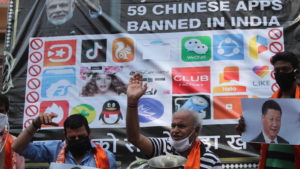In last couple of days a concept of self-reliant Bharat or India has popularized in ‘mainstream’, my bad, basically American social media networks esp. Facebook and their family of apps including WhatsApp and Instagram, an abrupt hatred has been artificially developed against Chinese apps. There is no such official stance by Indian government for obvious reasons.
To begin with, I am an independent freelancer who work online and deal with digital or computer stuff exclusively. I don’t use any agency to find me work for commission either. I am gregarious, isn’t it?
You would be startled to know that as of now I don’t use Facebook, Twitter, Snapchat, Instagram, WhatsApp, Skype, Google apps including Gmail, Microsoft Apps including Windows OS or popular Office Suite, Apple Apps including macOS or iOS. I figured out to live without it and not indirectly sell my data and intellectual property to US-based corporations that generate revenue which helps USA sell tangible war weapons to create unrest in a place to generate more money for States. Every wonder why China got where they are today? Chinese government has made Microsoft write a different version of popular Microsoft Windows operating system for privacy and security related issues.
In a blog post from 2017, Microsoft has revered Chinese government for having highest standards for security. Whereas our government apparently seem to blindly trust Mr Bill Gates as Messiah of closed-source software and cannot ever dare to think of it as a potential spy ware even in post-Snowden times. Although, I will not advocate the use of closed-source software ever however severely reviewed the software is and I am sure Microsoft is not interested in an independent review or audit either, if it were not for billions of dollars of money. China itself is preparing to drop Microsoft Windows soon.
If we ignore the intent of the Great firewall in China that filtered most of the digital products from western corporations including Google products. Chinese government focused on indigenous tools and services. It developed a whole ecosystem for citizens. Now it has evolved from basic replacement for western digital ecosystem to globally competitive things including payments not just social media or basic services for consumer like web search, email or cloud storage.
Smart-phone penetration in China is 59.9% versus 25.3% in India per Newzoo’s Global Mobile Market Report updated in 2019 with comparable population. Approximately 98% of China’s Internet users access it using their smartphone only. So, apparently Chinese love smartphones to communicate and connect. These powerful hand-held devices give an unprecedented opportunity to developers. They can now develop and release their ideas in form of functional applications to a huge potential client base with least resources to begin with. Owing to restricted access to the western websites and products, the huge Chinese consumer base was served with domestically cooked apps with a little spice of Nationalism and propaganda at first. Some of the most popular examples are WeChat, Weibo, QQ, Baidu, Youku etc.
WeChat – China’s own WhatsApp with integrated WePay as payment platform. It is not just instant messaging and internet calling. They extended the feature list to booking a taxi or flight, finding a hotel, paying bills, ordering your favorite grub, games and much more. So, it basically covers almost all the apps an average user in India has on a smart-phone in a single powerful application that you needed either-ways. The user experience of this app is so vibrant that it has ended up being an essential app for a Chinese consumer. This level of sophisticated integration of social networks and payment platform is considered to be way advanced and ahead of their western counterparts. Most countries in the world have recognized potential and have acted upon it. China being a leader with immense growth of digital payment ecosystems.
When you offer everything within your IM app as mini programs or apps, it tend to thrive like anything, in the first quarter of 2020, Tencent’s WeChat had over 1.2 billion monthly active users. Over half a decade ago, in 2015, non-cash payments in retail transactions was nearly 60 percent in China. There is competition in China too. Even in payment platforms. Before we talk about the competition let us talk about Alibaba.
Alibaba is the world’s largest retailer and e-commerce company. It is so big that it sometimes jokes about how it should not be compared to Amazon. It is so true because its sales and profits surpasses all US retailers combined including Walmart, Amazon and eBay since 2015. It served the Chinese middle class and understand their need for consumer goods. It has made history. It changed the way small Chinese businesses and retailers sell products. Aliexpress, an online shopping platform with independent sellers that has gained momentum outside China including India, Brazil, Singapore etc. It is most popular online shopping website among techies and geeks in India slowly getting views from non-techies as well. It is one of the most visited e-commerce site in Russia too.
It is not like Chinese don’t compete with themselves. A product called Alipay by Alibaba, which also is world’s largest mobile payment platform is competing with WePay by WeChat. Alipay has a 55.32% share of the third-party payment market in mainland China. In 2015, non-cash payments accounted for nearly 60% of retail transactions in China. Of all non-cash payments, Alipay and WeChat Pay earned 28% of all retail transaction fees to domestic economy; which otherwise would be 20 billion USD in fees on transactions using conventional card payment methods. So, promoting use of domestic payment platforms and integrating them with WeChat, a popular social media network has saved billions of USD for China. We are probably on a similar route theoretically with consumer benefits using RuPay and BHIM UPI. Their domestic payment platforms have been released in other countries of Asia and Europe. It is a true story of success with domestic mobile payments and its integration with indigenous social media network like Tencent’s WeChat Pay that took share from market leader Alipay. According to a report in South China Morning Post published in Jul 2018, WeChat Pay and Alipay combined has more than 80% of the country’s mobile payment segment along with other domestic partners. China is often seen as the first nation to move towards a completely cashless society because there are various reports from China, where cash is being refused and government has to issue direction to accept non-mobile payments i.e. cash and plastic or conventional cards. Central is forced to crackdown against domestic sellers not accepting cash. You can imagine the power of smart-phones in hands of a common Chinese citizen, no doubt mobile-based platforms has changed their world. It has generated domestic revenue and helped these companies reach other potential customers world-wide. After winning the local race, these mobile payment platforms are planning to serve their own people elsewhere including business and leisure tourists in North America, Japan and Europe. Alipay is also a popular online payment platform available at many web services that you might already be using today.
These are the questions we need to ask ourselves and the government. Can we do something about making UPI a global payment platform? Why has not UPI conquered India? Cannot we compete with China’s Alipay and WeChat Pay with more or less same amount of people? We have more youth than any where else in the world, what is wrong with the approach then? We had this cashless initiative during demonetization and lockdown owing to COVID pandemic. But, there is just no seriousness, even among youth and those who can. WeChat Pay is something that US-based Facebook’s WhatsApp is trying to achieve in India with UPI. It would have been different if we rejected Facebook’s data sharing with headquarters and developed our own domestic platform like China did. We need not follow China per say as we are a democratic country but we should think about our growing reliance on American corporations like Amazon or Facebook.
China developed their own Twitter called Weibo with 550 million monthly active users versus only 330 to 336 MAUs for Twitter world-wide. Weibo is a social network that has build its reputation in China. Even International brands has to interact with this domestic network to gain attention of social media celebrities. India does not even have any big local social network. How did a country like India that is known for coders not create a social or digital network of our own? These are things we need to ponder. There is a lot more going on other than the Chinese Internet in China.
We all wrongly believe that all the Chinese products are cheaper copies of their western counterparts or flagship products that are developed with help from Chinese government that don’t care to protect Intellectual property rights. It might be true. But we cannot turn a blind eye to world-class companies and corporations from China that are going global now. Chinese companies are working on real tech innovation and not just replication, if any. They are taking it as a challenge and competing with western counterparts not just by improvisation but also by real innovation by testing and releasing totally new concepts into a product. China is a emerging and vibrant economy, people with more money to burn are spending time online on their latest smartphones versus youth in India with little or no money to spend. The companies, developers, manufacturers are working on new ideas to impress their consumers with a penchant for bleeding edge digital products and consumer goods.
Let us take a look at Huawei. It is a world leader in networking equipments, I am sure most Indians have used Huawei routers if not phones. According to a leading research company Gartner, Huawei comes 2nd with Korean Samsung leading the world in terms of sales and had a market share of 15.8% in 2nd quarter of 2019. Despite US ban, Huawei did not lose hope and immediately started to work on a local replacement to Google Mobile services and apps. They came up with Huawei Mobile services and AppGallery. It is not just will power but also tech innovation that has kept Huawei’s moral and spirit high in harsh times. The very fact that it is always on the top of the charts in DXOMARK’s ratings for smart-phone lenses and camera makes them tech innovators and not just cheap replicator of western brands. Sales of Huawei has gone up in 2020 amidst ban by US government, thanks to patriotic Chinese citizens. We as Indians don’t even have a domestic brand to help our nation in hard times like this, when it comes to smartphone. Who do we support, if China also boycotts us or if US bans us for similar reasons?
Another giant from the land of dragon is Xiaomi. It is third largest smartphone company in the world. When Xiaomi first came to India, I did not even consider buying a smart-phone from them. Not because they were bad, but they were so hard to get. Xiaomi sold it like elixir in India. People just some how wanted to grab one. Xiaomi released most of the budget phones with quality hardware and recent specifications online, it still does. It was a new strategy, but it works so well that today Xiaomi’s market share in India is 25.9% and it has conquered the Indian market leaving Samsung behind at 20.89%. So, the success story of Xiaomi’s Mi series and then sub-brand Poco esp. the flagship model Poco F1 is mind-boggling but Chinese manufacturer did not stop there. It expanded from Pen to Shoes to other home consumer goods and electronics. Today, Xiaomi has plants in India for local integration and collaboration. It is selling low cost yet amazing TVs in India beating Sony, Samsung and LG in terms of market share and growth. Chinese Xiaomi has conquered smart-phones and TV market share of India. It would not be possible without tech innovation and quality after-sales service. You cannot expect growth like this in another nation without world-class management and infrastructure. These companies also focus on capacity building and quality delivery of services at full capacity.
Other worth-mentioning brands are Oppo and its sub-brand Realme, which are in top 5 position World and India respectively. Realme is also amazing India and the world by competing Chinese Xiaomi in India as it has already launched its own TV series like Mi TVs aiming to capture some of the market share from Mi and other Korean or Japanese brands.
While working on domestic needs owing to Chinese firewall, Tencent’s Wechat platform has received a lot of success. It is now world’s fifth most valuable company surpassing Facebook. Who could imagine forceful boycott of western companies will bring so much value while working on domestic products.
China’s own Uber style ride-sharing application called Didi, which is considered to be a Chinese copy has gone global. It introduced many new ideas to the application like service to call driver when you are drunk and SOS feature for security and safety of the passenger. These are simply innovations that are introduced in the product at a faster scale unlike their western competition. World’s market is every growing and an educated consumer loves to get impressed by tech developers. In fact, as one Chinese entrepreneurs respect competition which means Chinese businesses have no choice but to innovate and bring new things into a product.
For instance, in order to address the issues of traffic, time management with public transport, parking issues with private vehicles and pollution, a new tech innovation of bike-sharing has succeeded in China. Ofo backed by Didi and Mobike financed by Tencent being the two popular and most successful ones and were valued at 1 billion in 2017 only. Bike-sharing is a unique yet leading business model in China that is slowly paving its way outside China. It is helps consumer of various class with quick and one of the cheapest transport. It can be useful for a young tech consultant versus waiting for a bus to save time and also help a labourer reach workplace in as low as 15 cents. It has effectively solved the last kilometer issue which refers to the distance from metro station or bus stop to final destination.

Owing to no requirement of docking stations, consumers can park their shared biked anywhere, making it the perfect choice for these conditions. In last couple of years both Ofo and Mobike has received investment and help from both domestic giants Alibaba, Xiaomi and Taiwanese Foxconn, the leading contract manufacturer and supplier for Apple. Thanks to locally develop payment platforms, the idea of sharing things i.e. from bikes, to electronic scooters to even umbrellas is in vogue. There is just no stopping to the level of tech innovation and competition in China as of now. No one even waits for a segment to be saturated before sharing something new. Many researchers looks at China to imagine vehicle or transport ownership and its future. China has brought innovation with vibrant models in transport industry with above said local payment platforms that it had used for shopping and other consumer needs. Local adoption of sharing things including means of transport has brought confidence in these Chinese brands to expand their businesses outside China.
DJI, a reknowned and world’s leading drone maker is another innovation of Chinese brain. It is not just copying things that China might have originally did as a child learns seeing others but it has also given new concepts in existing products and designed new things in realm of consumer goods with primary focus on domestic platforms.
Conclusion
Both India and China have similar populations. But India is a country with more young population in comparison. Yet we have less smart-phone penetration. Regardless, we must utilize this drive to be self-reliant in a positive manner and focus on solving domestic issues with indigenous software and hardware platforms over the time. Software can be quickly developed and deployed with help of Free and Open Software solutions that are available for most of the consumer’s necessities. We should be least reliant on American solutions and value our data. Isolation or boycotting cannot be a solution in a democratic country but figuring out quick solutions to the problem at hand is the only way to a self-reliant India. We already have a payment solution available called UPI which can be used to solve a lot of issues related to shopping, transport and much more.
In the end, eager skillful and playfully clever domestic consumers led transformation and innovations in Chinese companies and their policies resulting in improvements in quality of goods and services at light speed both locally and abroad. India has adequate young workforce to think, design and deploy its own solutions in the digital realm for starters which can in future join hands with more local startups to serve our nation with confidence. In the end competing is the only way out. We cannot just boycott China or any other nation completely, just like that. Instead we must learn from it. Our boycott in world of globalization won’t stop China’s products from reaching you via a network of proxy companies that is going to cost us even more than what it does right now. As a consumer also you cannot be vocal for local when there is none.
One last thing; you must never shun foreign investments. In the very beginning Alibaba itself also received a 20 million USD foreign investment from Japanese SoftBank and 3.32 million USD from American Goldman Sachs. Had Alibaba not entertained it, perhaps things would be different and maybe Alibaba would not topple the world in their respect field of work and inspire other local businesses to dream big in China.
Stay Safe! Have fun.









